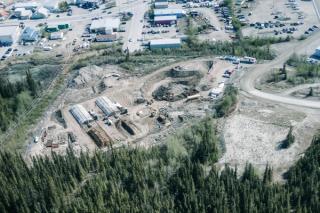
Former fuel oil depot – site investigation and remediation
- Client Name
- Public Services and Procurement Canada
- Location
- British Columbia, Canada

Challenge
A historic plume of non-aqueous phase liquid (NAPL) hydrocarbons was identified in fractured bedrock during the excavation of a roadside rock face. A heavy-end hydrocarbon product was observed oozing from exposed fractures and the excavation was halted to permit assessment and remediation of the NAPL.
Solution
Given the significant amount of bedrock outcropping on the site, it was recognised that geological assessment of the bedrock exposures was important to identify structural features that might be controlling the preferential migration of NAPL.
A geological mapping programme was subsequently undertaken to assess bedrock outcrops for fracture density, fracture aperture, the orientation of primary fracture sets and lithologic contacts. The area was also inspected for macro structural features such as faults, deformation and erosional features that might influence contaminant migration. Fracture sets and lithologic contacts were mapped by outcrop location, and fractures with visible NAPL were mapped separately from those without NAPL.
The geological data collected was used to construct stereographic projections of structural planes on a stereonet. Poles to structural planes were plotted and colour-coded by area and by presence/absence of NAPL. The plots were then analysed individually, and as a composite plot, to identify the dominant preferential pathways controlling NAPL migration.
Impact
By superimposing these features on areas where NAPL was observed, NAPL delineation targets were effectively identified and the plume was subsequently delineated with confidence and remediated.

